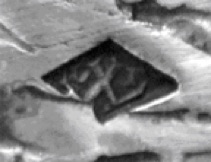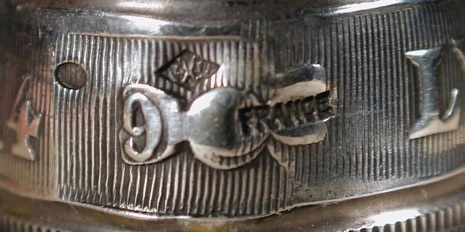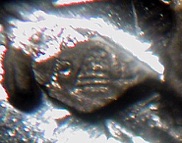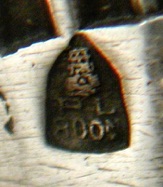More about Thimbles





Magdalena and William Isbister, Michel Painsonneau.
Introduction
Monsieur Pierre (P). Lenain is alleged to be a French thimble maker who made thimbles at the end of the nineteenth century and then reissued them over seventy years later in the twentieth century (1). Frank (2), writing about ‘Pierre’ Lenain, states that ‘Lenain is probably the best known French thimble maker in the United States thanks to the reissue in the 1970s of some of the thimbles with waffled knurling’. According to the traditional ‘wisdom’ of thimble collectors, the original thimbles were made by ‘P. Lenain and Co.’ (according to many Anglo-Saxon writers the ‘P’ stood for ‘Pierre’ [1, 3, 4, 5, 6, 7,]), Parisian gold and silversmiths, and they were then reissued by the same ‘P. Lenain’, using the original dies, some 70 years later (1, 6). If ‘P. Lenain’ had made the original thimbles he would have had to be at least 20 years of age, and probably older, when he became a master which would mean that he would have been at least 90 years old when he reissued the same thimbles in the 1970s. This is clearly impossible.
‘Pierre Lenain’
What is known of this ‘P.’ or ‘Pierre’ Lenain? Holmes does not mention Lenain in relation to French thimbles (8). McConnel, mentions ‘P. Lenain’, but does not associate the name with any specific thimbles (9). There is no mention of ‘P. Lenain’ in two recent French thimble texts (10,11) and early American authors similarly do not mention the name of Lenain (12).
The first reference to ‘P. Lenain’, ‘’Europe’s most prestigious silversmith’’ according to Belford, is to be found in a ‘Collectors Yearbook 1979’, a brochure from Rosalind Belford (‘Sewing Corner’ and later ‘Collectors Choice’). The name first appears in the thimble literature, in 1986 in von Hoelle (13), and it is suggested that this is based on information given to von Hoelle by Belford who, at the time, was selling reissued de la Fontaine fable thimbles which were made by ‘Orfèvrerie Lenain’ (14). Von Hoelle probably assumed that the same company made the original thimbles. ‘P. Lenain’ is mentioned in Zalkin (15) who probably based her information on von Hoelle. The name ‘Pierre’ Lenain seems to first appear in the thimble literature in 1992 (3, 4). It is repeated by several Dutch and German writers but no references regarding the origin of the name were ever cited (1, 5, 6, 7).
Frank’s statement regarding the fame of Lenain probably explains the widely held view linking ‘Pierre Lenain’ to the manufacture of the de la Fontaine fable and other French thimbles in Anglo-Saxon minds. In addition, over the years ‘P. Lenain & Co.’ and ‘Pierre Lenain’ have come to be associated with two ‘royal’ thimbles but in fact it was A Féau and not ‘P. Lenain & Co.’ who made a wedding gift of a thimble to Queen Wilhelmina, and the thimble that was thought, incorrectly, to have been a wedding gift from a South African President to the same Queen was not made by ‘P. Lenain & Co.’ either (16). The entire ‘Pierre (P.) Lenain’ story thus seems to date back to Belford.
It is difficult to get detailed information regarding French thimble makers of the late 19th and early 20th centuries. We were fortunate, however, to be able to get in touch with descendants of both the Lorillon and Lenain families and together with the Chef de la Cellule Technique de Garantie de Paris (Bureau of Garantie of Paris, Bureau of Customs, Paris) we have been able to discover some new information about the Lenain thimble makers.
Maison Lenain, Paris
Louis Lenain, 11 rue Meslay, registered his mark in 1906; it was re-registered in 1911 when he moved his workshop to 16 rue Dupetit-Thouars and cancelled in 1920. It comprised ‘LL’ separated by two interlaced ‘L’s, one reversed. According to his grandson Roger Lenain, Louis did not make thimbles but concentrated on silver tableware and to our knowledge, his mark has not been found on a thimble.
Next the company became ‘Lenain et Fils ainé’, 16 rue Dupetit-Thouars. The mark was ‘L& Fils’ with two interlaced ‘L’s, one reversed and it was registered in 1920. It is doubtful whether thimbles were made at this time either. In about 1925 Louis Lenain’s son Philippe took over the business and according to Philippe’s son, Roger, they bought thimbles from Lorillon/Féau. In 1929 the company became ‘Lenain Frères’, still at 16 rue Dupetit-Thouars and the mark registered at this time was ‘LF’ separated by two interlaced ‘L’s, one reversed.

The company name changed again in 1938 when it became ‘Lenain et Cie’ of 16 rue Dupetit-Thouars and later 32 rue de Picardie. The mark remained the same. According to Roger Lenain, his father did not manufacture thimbles but concentrated on other forms of jewellery making and silver tableware. Roger worked in his father’s workshop until 1945.
It was later, in 1964, that Roger Lenain developed the thimble side of the business when he bought ‘ Le Dé à Coudre’, a Lorillon/Féau company and gained access to all the old Lorillon/Féau dies.
In the 1970s, Roger Lenain (Orfèvrerie Lenain) re-struck many of the Lorillon/Féau thimbles and marked them with Lenain et Cie’s mark. The re-struck de la Fontaine Fable thimbles for the foreign market, for example, thus had the Lenain et Cie maker’s mark and in addition, they had a numerical finger size, the word ‘France’ and the Mercury head export assay mark (the size number and ‘France’ were omitted from re-issues destined for the domestic market and a crab replaced the Mercury head).

These re-issued thimbles were attributed to ‘P. Lenain & Co.’ by von Hoelle (13) who also incorrectly described the ‘touchmark’ as ‘a diamond with an L and an F separated by a large X with the diamond.’ This description has been responsible for the widely held view that these thimbles were first made by ‘P. Lenain & Co.’
In the 1980s, Roger Lenain was himself bought out and thimble production finally ceased in the Lorillon – Féau – Lenain workshops.
The mark – PL separated by a thimble
We have been unable to find or identify any mark registered for a ‘Pierre’ Lenain’ although, by law, had a ‘Pierre’ Lenain been making silver thimbles he would have been required to register a mark. The marks below, PL separated by a thimble, have been found on early 20th century thimbles but we have been unable to trace, authenticate or find any evidence of the registration of the marks. In spite of much research, the service of the guarantees of Paris was not able to find any trace of the mark in its many files either.


It has been claimed that these marks are the marks of ‘Pierre Lenain’ but this is clearly impossible (7). They seem most likely to be ‘Lorillon’ marks because they have been found on de la Fontaine fable thimbles of the early 20th century that were identical to those known to have been made by Lorillon. They have also been seen on other thimbles to be seen in a Lorillon catalogue of the time. There was often marriage between thimble making families and it is known that the Lorillon-Féau families were close and in fact merged their workshops to form ‘Le Dé a Coudre’ in 1927. When unions of this type occurred, in the same place and around the same time of registration symbols in masters’ marks were often preserved. A buffalo was thus used by J Lorillon and then A Féau and finally by R Lorillon. A Féau also used the thimble emblem. It would thus not be surprising for a Lorillon to use a thimble in his mark too. René Lorillon died at an early age (24 years) in the Great War and although he did have a son called Pierre, we do not think that the mark belonged to him. Pierre was too young and not a goldsmith. Our research enables us to propose that Louis Plumont was the probable owner of this mark.
Louis Plumont was a goldsmith and collaborator of René Lorillon and on René’s death took charge of the workshop under the direction of René Lorillon’s wife. When “Le Dé a Coudre” was created, Louis Plumont’s wife became manager. Plumont thus had access to the Lorillon dies and it is not surprising, therefore, to find similar thimbles with either R.L. (Lorillon) or P.L. (Plumont).
Louis Plumont was a manufacturer of thimbles in his own right. He was also an impassioned collector of paintings and was a patron of Conrad Kickert, the Dutch painter of Montparnasse. On the recommendation of the director of the Visconti gallery, Kickert was invited to exhibit at the ‘salon de la Folle Enchère’, in November 1923, and there he sold “Le Chêne de l’enclos”, N° 89, in the catalogue to Mr. Louis Plumont, a ‘’manufacturer of thimbles who lived in Cormeilles-in-Parisis’’ on the outskirts of Paris (17). In June of the same year Kickert stayed with Plumont in Cormeilles-in-Parisis and the families became friends.
One might expect that the mark for Louis Plumont would be ‘LP’ separated by a thimble however the mark is actually ‘PL’ separated by a thimble. It is possible that LP represents Plumont Louis, but it seems more likely to represent Plumont - Lorillon because the owner of the workshop at the time was René Lorillon’s widow. The emblem, the thimble, is one of the emblems found in early marks of the Maison Féau, predecessor of Lorillon.
Conclusion
‘Pierre Lenain’, the thimble maker, is not known in France, nor is he a member of the Lenain silver and goldsmith family, and we have been unable to find any evidence, from either family members or the French Office responsible for registering master silver and goldsmiths in Paris, to support the notion that ‘Pierre’ Lenain was a master silversmith or goldsmith or a thimble maker in his own right. Although we did find Philippe Lenain, possibly the P. Lenain of von Hoelle’s ‘P. Lenain & Co.’, we were informed by his son, Roger, that he did not make thimbles. The master’s mark attributed, by some, to ‘Pierre Lenain’ most probably belongs to the Lorillon company whilst it was owned by René Lorillon’s wife and managed Louis Plumont. The name of ‘Pierre Lenain’ should therefore be dropped from the thimble literature.
Acknowledgements:
We are especially thankful to the persons listed below who did respond promptly to our many questions:
Ghislaine Chaplier who answered many, many emails and relayed information from Monsieur Roger Lenain.
Wolf-Dieter Scholz who made his vast library of references available to us.
Personnel of the service of Guarantee of Paris under the Administration of the Customs who assisted in the identification of several maker’s marks.
The Palissy database of the Ministry of Culture where we found many of the maker’s marks. Available from:
http://www.culture.gouv.fr/documentation/marque/orfeo-frame.htm
References:
1. Kamp F, Die Fabelfingerhüte von Pierre Lenain. Vingerhoedniews, 1995, 34: 4.
2. Frank B. Thimbles of France with waffled knurling. Thimble Collectors International. USA. 2003.
3. Holmes EF. Thimble Notes and Queries 1992; 17: 13.
4. Holmes EF. Thimble Notes and Queries 1992; 18: 18.
5. Langedijk CA. Das Missverständnis um zwei goldene Fingerhüte. Rund um den Fingerhut, 2001;33: 4.
6. Sullivan K. Thimbles. Antique Collecting, 2004; 39 (2): 24.
7. Mohr G. Günter Mohr stellt Sammler vor (2). Rund um den Fingerhut 1989; 10:19.
8. Holmes EF. A history of thimbles. London: Cornwall Books, 1985. pp. 69.
9. McConnel B. The story of the thimble. Atglen, PA.: Schiffer Publishing Ltd, 1997. pp. 113.
10. Crestin-Billet F. La folie des Des a Coudre. Paris: Flammarion, 2003.
11. Crestin-Billet F. Ouvrages de dames. Paris: Tana, 2005.
12. Lundquist M. Thimble treasury. Des Moins: Wallace-Homestead Book Company, 1975
13. von Hoelle JJ. Thimble collector’s encyclopedia. Illinois: Wallace-Homestead Book Company, 1986. pp. 134.
14. Crestin-Billet F. Ouvrages de dames. Paris: Tana, 2005. pp. 77.
15. Zalkin E. Zalkin’s Handbook of Thimbles & Sewing Implements, 1st edn. Willow Grove: Warman Publishing Co., Inc., 1985. pp. 36
16. Aardewerk B. The famous Vernon thimble. Thimble Society Magazine, 1992; 4(6): 4.
17. Association Conrad Kickert, Pleaux, France. Conrad Kickert . Le peintre hollandais de Montparnasse. Available from:
http://www.conrad-kickert.org/
TCI Bulletin Winter 2008
Holmes: ‘Thimbles in France’ pp. 65.
Researched and published in 2002/11
Copyright@2011. All Rights Reserved
Magdalena and William Isbister, Moosbach, Germany
‘pierre lenain’ - the myth
Navigation
